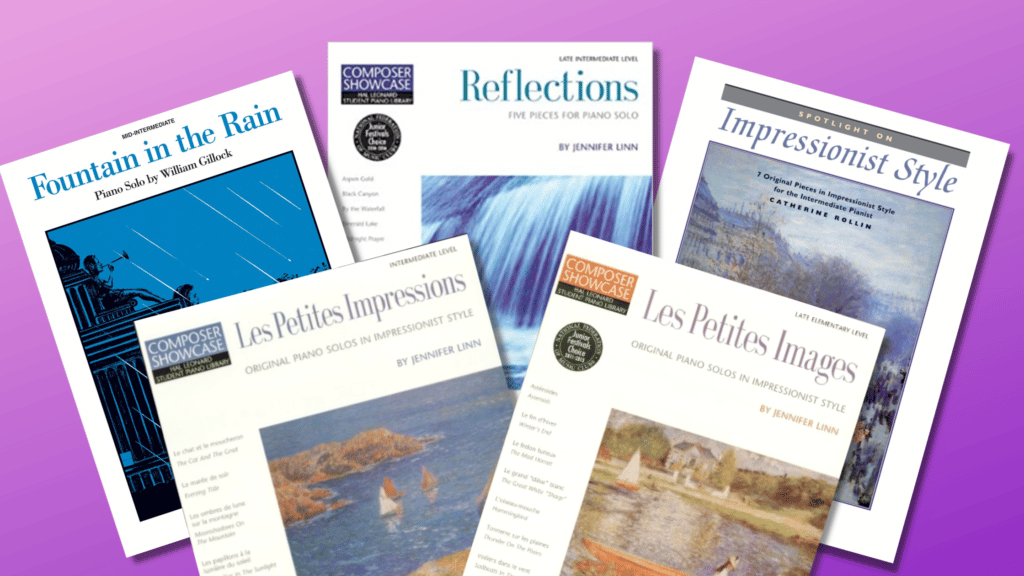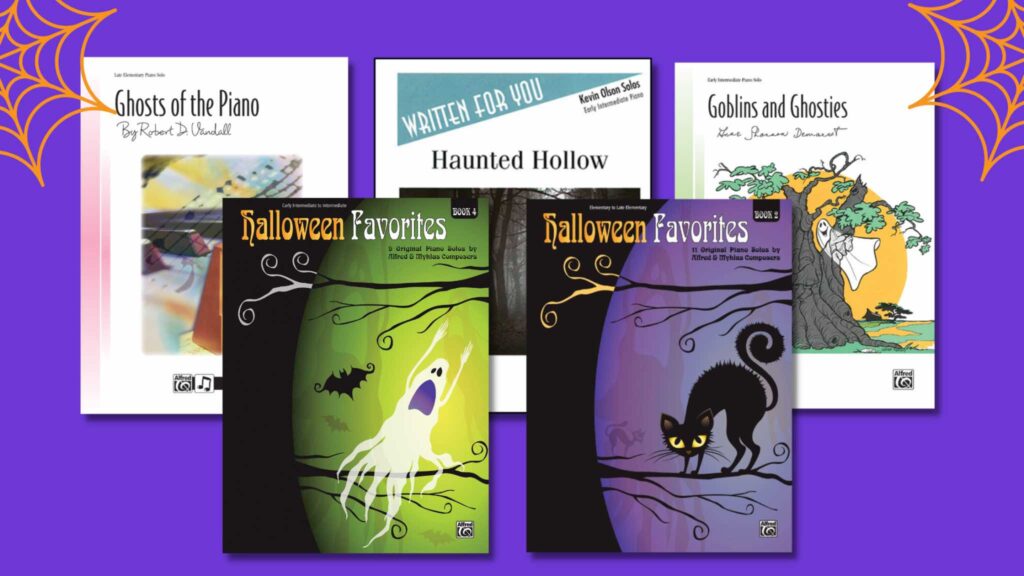Clair de lune by Claude Debussy always ranks as one of our most-requested piano favorites! This piece has been performed often, arranged for orchestra, and featured in numerous movies including Godzilla, Ocean’s Eleven, and The Twilight Saga. But, what is it about this music that is so alluring to audiences? The lush and sometimes unexpected harmonies, the sweeping gestures, and the episodic passages that flow from one to the next are all features that make this piece irresistible to the listener. Music in the Impressionist style can likewise be very motivating for students. Here are some ideas and repertoire suggestions to introduce Impressionism at any level!
What Makes It Impressionism?
Initially used to describe work by painters like Claude Monet and Vincent van Gogh, the term also became associated with the musical style of Debussy, although he himself disliked the label. Debussy’s music and that of other early Impressionist composers contained unique features that are now iconic to the style. Many emphasize creating new sounds and colors in the music. Some of these characteristics include:
- Nonfunctional harmonies
- Unresolved dissonance that creates color
- Variety of scales, such as church modes, pentatonic scale, whole tone scale, etc.
- Nontraditional cadences
- Extended chords, such as 9ths, 11ths, and 13ths
- Use of pedal for colorful effects and blending of harmonies
- Chord planing, also known as parallel chords
- Ornamentation that obscures the melody
- Less emphasis on strict forms
- Descriptive titles, often mentioning light and water
Why Study Impressionism?
Impressionism teaches students many performance skills; it helps them learn to communicate imagery in their performances through variety in articulation, layering of sound, special pedal effects, variety of touch, and more. It also teaches excellent listening skills, balance of textures, voicing, and musical sensitivity. We think it is a style not to be missed!
Beyond this, Impressionism contains many features which are found in other Contemporary genres. For example, extended chords like 9ths, 11ths, and 13ths are found frequently in jazz harmonies. You can use Impressionist music as a starting point to many other new explorations.
Finally, Impressionism provides a chance to learn about many unique theoretical topics. Maybe your student finds minor scales interesting … but have you told them about the hexatonic or whole-tone scale that is built only using whole steps? What an opportunity to enhance the theory curriculum with real examples!
Choosing Music
While well-known Impressionist composers like Debussy and Ravel tend to be the most famous of those associated with the style, many of their works are for late-intermediate or advanced pianists. But, there are many Impressionist-inspired selections by educational composers to prepare our students and allow them to experience this style. To assist in choosing repertoire, the following are some examples of works to explore with your students, categorized by level. This is not an exhaustive list, but just a few ideas to get you started!
Elementary: “Rainbow Fish” by Catherine Rollin
Get the sheet music for “Rainbow Fish” here.
Late Elementary: “Tonneres sur les plaines” from Les Petites Images by Jennifer Linn
Get the sheet music for “Tonnerre sur les plaines” here.
Early Intermediate: “Voiliers dans le vent” from Les Petites Images by Jennifer Linn
Get the sheet music for “Voiliers dans le vent” here.
Intermediate: “Fountain in the Rain” by William Gillock
Get the music for “Fountain in the Rain” here.
Intermediate: Water Lilies from Spotlight on Impressionist Style by Catherine Rollin
Get the music for “Water Lilies” here.
Late Intermediate: “By the Waterfall” from Reflections by Jennifer Linn
Get the music for “By the Waterfall” here.
Collections to Explore:
Les petites images by Jennifer Linn (Late Elementary to Early Intermediate)
Les petites impressions by Jennifer Linn (Intermediate)
Spotlight on Impressionist Style by Catherine Rollin (Intermediate)
More Impressionistic Composers
Studying the works of Debussy and Ravel is fantastic, but it is important to remember that there are a multitude of other pieces by lesser-known Impressionist composers. If you or your students want to explore even more imagination and creativity, be sure to check out some of these musical visionaries too! Many of the works by these composers are at the early advanced level and above.
Lili Boulanger (1893-1918, France)
Frederick Delius (1862-1934, England)
Manuel de Falla (1876-1946, Spain)
Charles Tomlinson Griffes (1884-1920, United States)
Mary Howe (1882-1964, United States)
Jacques Ibert (1890-1962, France)
Frederico Mompou (1893-1987, Spain)
Ottorino Respighi (1879-1936, Italy)
Karol Szymanowksi (1883-1937, Poland)
Toru Takemitsu (1930-1996, Japan)
Germaine Tailleferre (1892-1983, France)
Let’s Go!
For further reading on this topic, we recommend Hayden Coie’s article “The Actual Children’s Corner: Making Impressionistic Music Accessible to Elementary and Intermediate Piano Students” in Piano Magazine’s 2018 Winter edition.
We hope you enjoy exploring the Impressionist style with your students! Do you have your own Impressionist favorites for students? We would love to hear about them in the comments!



